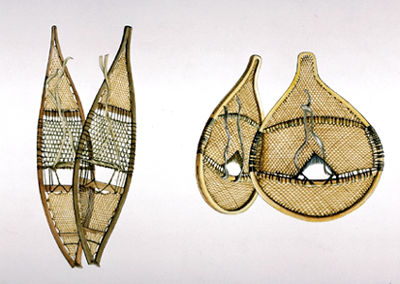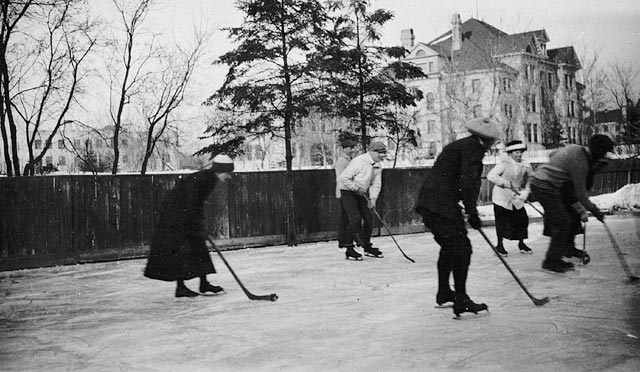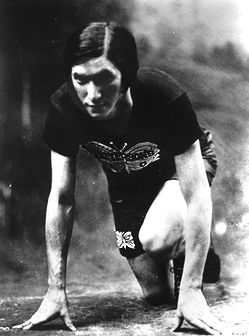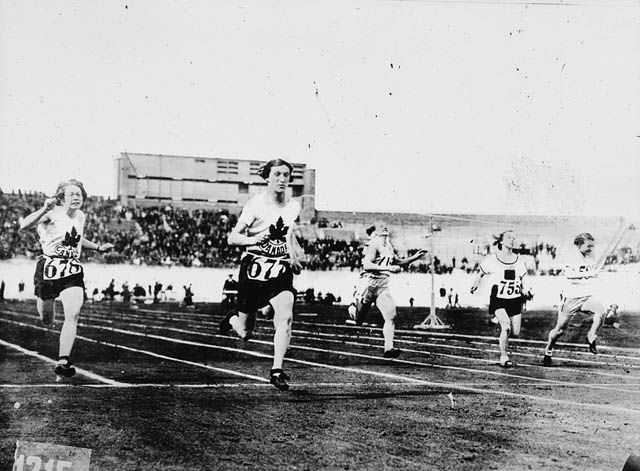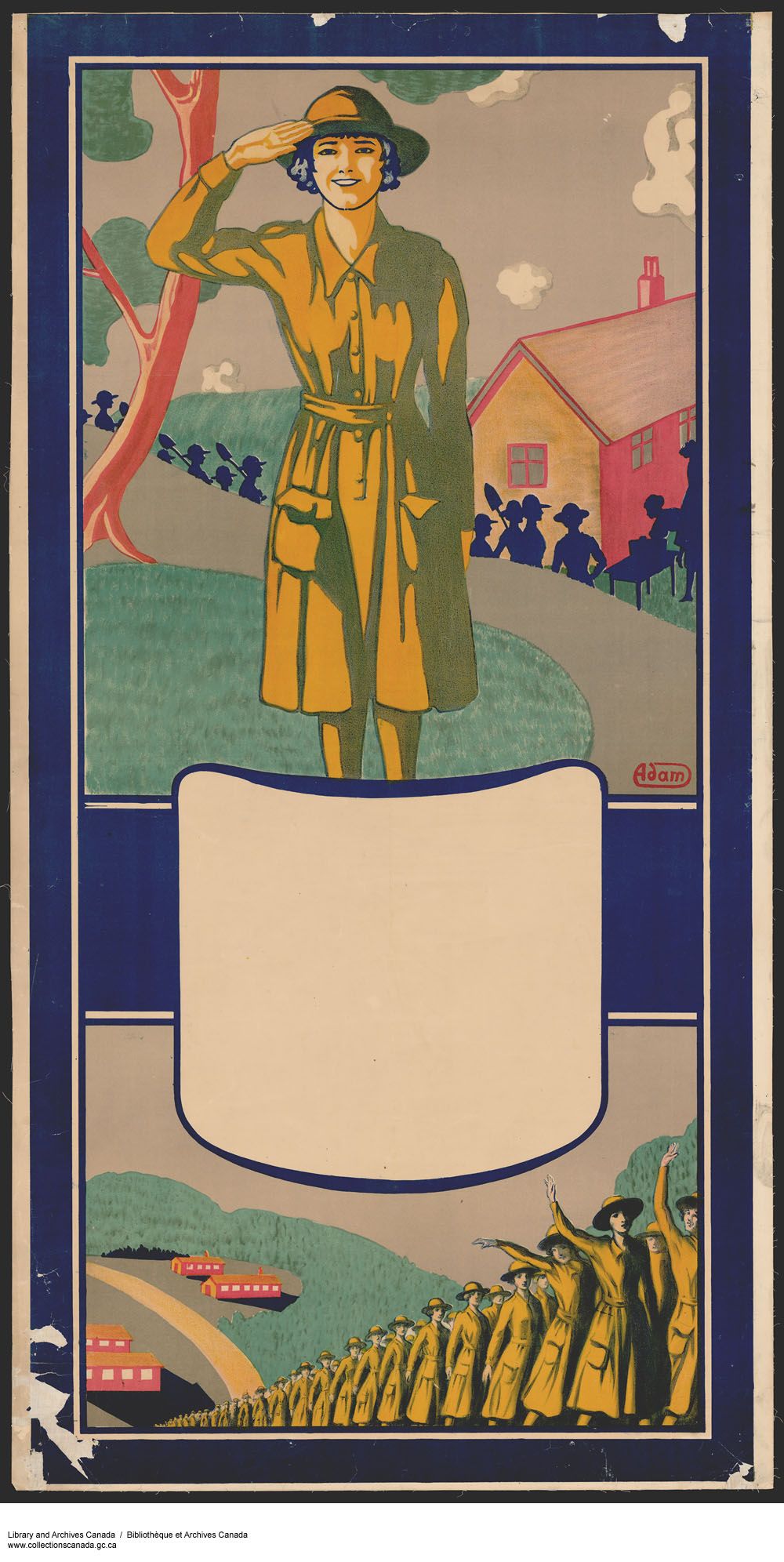For hundreds of years, very few sports were considered appropriate for women, whether for reasons of supposed physical frailty, or the alleged moral dangers of vigorous exercise. Increasingly, women have claimed their right to participate not only in what were deemed graceful and feminine sports, but also in the sweaty, rough-and-tumble games their brothers played. In the 21st century, many previously forbidden sports (e.g., boxing, soccer, rugby) have been opened to female players.
Pre-Colonial Period
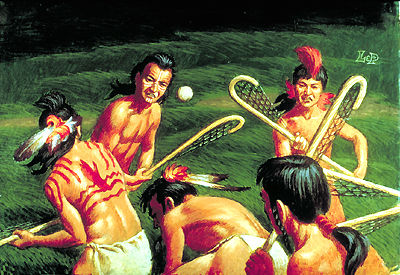
While historians know relatively little about the lives of Aboriginal women in the pre-colonial period, it is likely that women participated in some games and contests, including the precursors of shinny, lacrosse, and football. In many tribes, the games were reserved for men only, but in others, certain games were played by women alone, or by both sexes.
Shinny, a game which is similar to hockey, was often considered a women’s game. Players would use a curved stick to hit a small round ball made of wood or stuffed buckskin along the ground or ice. Double ball, a more difficult and faster game than shinny, was primarily a women’s game in which they used long sticks to toss two balls that were tied together with a thong.
However, European colonization would restrict the opportunities for Aboriginal women, as they were increasingly confined to small settlements and subjected to European ideas about appropriate female behaviour.
Colonial Period

With the arrival of European colonists came new pastimes and games, and different ideas about the place of women in sport and society. French and British traders, military men, and colonists brought new sports to the area, but these were mostly reserved for men. Women had little opportunity to engage in these sports, and the few recreational activities considered acceptable for women were usually restricted to members of the (white) upper classes.
In New France in the mid-17th century, upper-class women were encouraged to go horseback riding (sidesaddle) as it was considered healthy. Similarly, they could travel by sleigh (or carriole) in winter and horse carriage in summer. In the larger centres, dancing schools taught young women popular dances of the time, including minuets, hornpipes, cotillions, and country dances.
Victorian Age
For much of the Victorian era women had very few opportunities in the world of sport. However, there were some recreational opportunities for those women who had both time and money. In the winter, Victorian women in Canada participated in sleigh and toboggan parties, snowshoeing, iceboating, and skating (including fancy skating, the forerunner of figure skating).
In the summer, they enjoyed picnics, croquet, boating, fishing, horseback riding, and even fox hunting. Some women tried roller skating or “parlour” skating on hockey rinks, which were covered with wooden floors for the summer season.
Bicycles and Freedom
Women gained a new freedom and expanded athletic opportunities with the advent of the new “safety” bicycle in the 1880s. The earliest bicycles, such as the penny-farthing (also known as the “ordinary” or high-wheel bicycle), were both dangerous and uncomfortable to ride. A few select women, including Montréal’s Louise Armaindo, competed on penny-farthing bicycles in the last decades of the 19th century. Armaindo started out as a strongwoman and trapeze artist, then turned to pedestrianism (walking races) before she started competing on high-wheel bicycles in 1881, mostly in the United States.
In the 1880s, smaller, lighter bicycles were developed; these new bikes had equal-size wheels and pneumatic tires, and were powered by a sprocket and chain. The new “safety” bicycles made riding much safer and more comfortable, and they quickly became popular among both men and women. As more and more men and women started cycling, new (social) cycle clubs proliferated.
For women, bicycles provided exercise, entertainment, transportation, and freedom. The bicycle also led to much-needed dress reform. While it was possible to bike in long skirts, many women adopted shorter styles for riding, including the split skirt and the controversial “bloomer.”
Early 20th Century
By the end of the 19th century, growing numbers of middle- and upper-class women were participating in sports such as tennis, golf, and curling, and were forming separate ladies’ sporting clubs. Although these sports were considered more acceptable for women than team sports, female athletes were also starting to play games such as hockey, softball, and basketball by the turn of the century. The first women’s ice hockey teams appeared in the early 1890s in Québec, with clubs in Montréal, Trois-Rivières, Lachute, and Québec City. However, the games were played infrequently and were quite informal.
In general, there was little support for women’s team sports in most 19th-century communities. The drive for women’s team sports would come instead from the girls and young women who attended private schools, universities and colleges, and from the coaches and instructors who were determined to see them play. While no competitive sports were offered to girls in the public school system, private schools such as Bishop Strachan and Havergal College in Toronto emphasized sports and games for their female students. At Havergal, for example, girls practiced gymnastics, tennis, basketball, cricket, ice hockey, golf, track, and swimming. At universities — which women had started attending in the 1870s and 1880s — women competed in fencing, tennis, paper chase (the forerunner of cross-country races), ice hockey, field hockey, and basketball.
Edmonton Grads

Basketball, which had been invented by Canadian James Naismith in 1891, was the most popular women’s team sport in the early 20th century. For example, by 1910 most towns in Nova Scotia had women’s basketball teams. In the 1920s and 1930s, a women’s basketball team from Edmonton dominated the sport. Known as the Edmonton Commercial Graduates (or the “Grads”), these women — most of whom were graduates of the McDougall Commercial High School — played across the country and internationally, winning over 90 per cent of their matches, and over 100 regional, national, international, and world titles. Their success inspired other Canadian women to take up the sport, and to participate in athletic activities more generally.
Fanny “Bobbie” Rosenfeld
The most accomplished female athlete of the early 20th century (and perhaps of Canadian history) was Fanny “Bobbie” Rosenfeld, a Russian émigré who was nicknamed Bobbie because of her bobbed hair. The top-ranked female sprinter in Canada, she was also ranked number one in the long jump, shot put, and discus in 1925, and won Canada’s first Olympic medal in women’s track and field (a silver) in 1928. Rosenfeld also won the Toronto Grass Court Tennis Championship, and played competitive basketball, softball, and hockey (her favourite sport). She was the star centre for the North Toronto AAA hockey club and captain of the Patterson Pats, dominating Ontario women’s hockey in the late 1920s.
The World Wars
In the First and Second World Wars, women entered the workforce in high numbers; many of these women also participated in sports. Even though many men — including male athletes — had left to serve overseas, some games and tournaments continued, with women often taking the place of men on the playing field, as in the factories. These competitions were frequently used to support patriotic causes or to raise funds. ( See "All the Rage”: Women’s Hockey in Central Canada 1915–20 .)
The 1950s
With the return of men after the war, women were encouraged to return to the home, and increased emphasis was put on women’s femininity and on traditional gender roles. This affected not only women’s opportunities in the workplace, but also in sports. Yet again, women were encouraged to participate in sports that emphasized beauty, grace, and contemporary concepts of femininity.
One such sport was figure skating, with Barbara Ann Scott a perfect example of the ideal female athlete of the time. A two-time world figure skating champion, and two-time European champion, Scott was Canada’s first Winter Olympic individual gold medallist, winning the gold medal at the 1948 Olympic Winter Games in St. Moritz, Switzerland. Clearly an accomplished athlete, much of the media coverage emphasized her femininity rather than her athletic feats. A Time magazine feature from 1948 described her as follows: “Barbara Ann, with a peaches-and-cream complexion, saucer-size blue eyes and a rosebud mouth, is certainly pretty enough. Her light brown hair (golden now that she bleaches it) falls page-boy style on her shoulders. She weighs a trim, girlish 107 lbs … She looks, in fact, like a doll which is to be looked at but not touched.”
Women’s Liberation
Overall, the 1960s, 1970s and 1980s were years of enormous success for Canadian women in sports. The 1960s and 1970s witnessed the emergence of the “women’s liberation” movement in North America. Women increasingly fought restrictions in all areas of life, including sports.
Although there was little support for amateur athletes at this time, many Canadian women excelled at sports in this period. Prominent female Canadian athletes of the 1960s included swimmers Mary Stewart and Elaine Tanner, track athlete Abby Hoffman, and skiers Anne Heggtveit, Nancy Greene, and Elizabeth Greene. High-jumper Debbie Brill, the first North American woman to clear the six-foot barrier, dominated the sport in the 1970s. At the 1978 Commonwealth Games in Edmonton, Canadian women won gold in such sports as the pentathlon (Diane Jones Konihowski) and the discus (Carmen Ionescu), as well as in swimming and gymnastics.
Aboriginal Canadian twins Shirley and Sharon Firth, who had trained through the Territorial Experimental Ski Training program (TEST) in Inuvik, NWT, dominated cross-country skiing in Canada in the 1970s and 1980s. Black Canadian female athletes (many from the Caribbean) tore up the track in the 1970s and 1980s: Angela Bailey, Marita Payne, Jillian Richardson, Charmaine Crooks, and Molly Killingbeck. In 1984, Sylvie Bernier won Canada’s first Olympic gold medal in diving and Anne Ottenbrite became the first Canadian woman to win Olympic gold in swimming. In 1988, figure skater Elizabeth Manley won silver at the Olympic Winter Games in Calgary, and marathon swimmer Vicki Keith became the first person to swim all of the Great Lakes.
At the Top of Their Game
Canadian women continued to excel in the 1990s. Colette Bourgonje, a Paralympic athlete, competed in her first Winter Games in 1990 in cross-country sit-ski. (Also a wheelchair racer, she would go on to compete in eight Summer and Winter Paralympic Games.) Rower Silken Laumann, who won a bronze medal at the 1984 Olympic Games with her sister Daniele in the double sculls, overcame a devastating leg injury to win Olympic bronze in the single sculls at the 1992 Olympic Summer Games (Laumann was also awarded the Bobbie Rosenfeld Trophy in 1991 and 1992). At the 1996 Olympic Summer Games, she won silver in the single sculls. Her teammates, rowers Marnie McBean and Kathleen Heddle, won two gold medals at the 1992 Olympics, and a gold and bronze medal in the 1996 Olympics, becoming the first Canadians to win three Olympic gold medals.
In 1994, biathlete Myriam Bédard became the first Canadian to win two Winter Olympic gold medals. Two years later, track star Charmaine Crooks (who competed in five Olympic Games) became the first Canadian woman of colour to sit on the International Olympic Committee. Alison Sydor, winner of the 1996 Bobbie Rosenfeld Award, won a silver medal in mountain biking at the 1996 Olympics, and won three world championships in the sport (1994–96). At the 1998 Olympic Winter Games, Catriona Le May Doan won her first Olympic gold medal in speed skating (she would win again in 2002), part of a very successful women’s speed skating program which netted 18 Olympic medals from 1994 to 2010.
The 21st Century
The sporting world of the 21st century looks very different to that of the Victorian period, or even the 1960s. Across the country, women are participating in high numbers in sports, including those traditionally seen as masculine or inappropriate for women. Young girls and women play rugby, soccer, and softball; like Carol Huynh and Tonya Verbeek, they wrestle, and some (like Mary Spencer) box competitively.
Moreover, some female athletes have gained both female and male fans across the country. Take, for example, the national reaction to the victory of the Canadian women’s hockey team over the US team in the 2002 Olympic Winter Games, and in the 2006 and 2010 Games. Hockey players such as Angela James, Hayley Wickenheiser, and Geraldine Heaney have become famous. The 2010 Olympic feats of female athletes such as freestyle mogul skier Jennifer Heil, and bobsledders Kaillie Humphries and Heather Moyse, were celebrated across the entire country. Clara Hughes, OIympic speed skater and cyclist, is widely lauded for her sporting success as well as her activism, and the 2012 women’s Olympic soccer team became national celebrities, even after losing a heart-breaking semi-final match to the US team; in 2013, the team’s captain, Christine Sinclair, received a star on the Canadian Walk of Fame.

 Share on Facebook
Share on Facebook Share on X
Share on X Share by Email
Share by Email Share on Google Classroom
Share on Google Classroom

